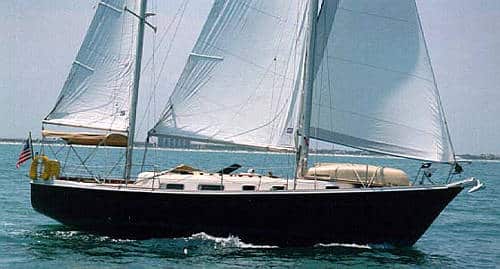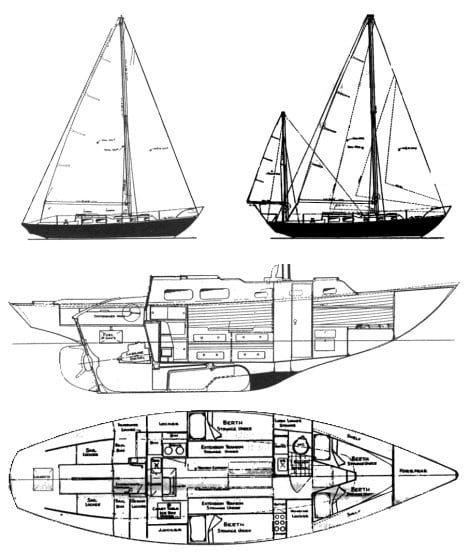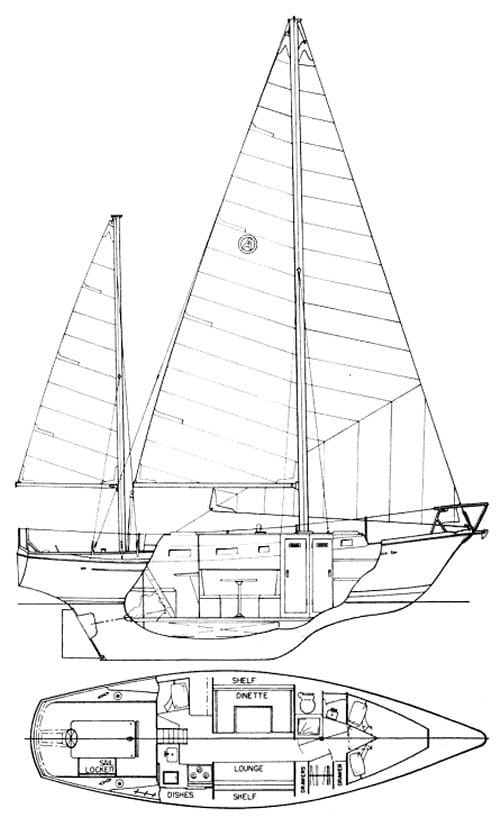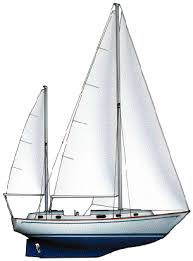
Allied Seabreeze

The Allied Seabreeze began her commercial life as a true sailor’s yacht. Hull #1 had barely arrived in City Island, New York, in the summer of 1963 when the yacht’s co-designer, Frank MacLear, faced with presenting the boat to prospective buyers, suggested leaving the dock under sail. To keep a good thing going he brought her back alongside under sail, too. Two contracts followed that day and the Seabreezes kept coming out of the Catskill, NY-based Allied Boat Company yard until 1973 when the last hull, number 135, was completed.
In the 1960 SORC, Thor Ramsing, the financial force behind Allied Boat, won class A with his centerboarder, Solution. He decided that a 35-footer on similar lines drawn by MacLear & Harris would make a popular production boat. As it happened, Frank MacLear and Bob Harris were working at the time for Sparkman & Stephens on Finisterre, a centerboarder destined for fame. Influenced by their own sailing experience in shallow-draft centerboard designs by Phil Rhodes and Aage Nielsen, they could not help but produce another American classic.
In the 60s many family-owned boats participated in club races under the CCA rule, which favored a small mizzen, so most of the Seabreezes sold as yawls. The rule also encouraged a short waterline. The 34’6″ LOA Seabreeze, with only 24’0″ of LWL, certainly fit that bill. Beam of 10’3″ gives the boat a roomy interior with pilot berths and seats extending into bunks. The hullÕs moderate draft of 3’10″ increases to about 7’0″ after dropping the board to the recommended 50¡ from horizontal.
The standard 380-pound bronze board of the early years was replaced by an aluminum version in 1967 weighing 115 pounds. Fortunately it still pivots on a kingpin accessible from inside the bilge. In 1970 a Citation Seabreeze went on the market ÒimprovedÓ with a main cabin longer by a foot, a dinette, a two-door head compartment and a slightly longer cockpit (at the expense of lazarette space). The rudder was changed to a trapezoidal form to fill the gap under the counter overhang.
A report culled from 109 members of the Allied Seabreeze Owners Association reveals a group of sailors dedicated to this lovable design. Most of the boats have been adapted for use by couples. The pilot berths have changed to extra storage cabinets, and lockers now house reefer/freezer units, air conditioning and the latest electronics. The bulkheads shine with varnished teak. Cockpits sport steering wheels instead of tillers, and invariably, power comes from diesel engines. All these improvements bring more weight aboard, slowing down this once nimble design.
The Allied Boat Company did a very good glass lay-up job and owners only rarely report limited blistering or small separations in the balsa-cored decks. Some of the older boats tend to break chainplates, usually on the lower shrouds, threatening to topple the deck-stepped mainmasts. The chainplates, which are buried in fiberglass gussets for most of their length, should come out at regular intervals for inspections or be replaced with an alloy more resistant to crevice corrosion.
A well-maintained Seabreeze makes a strong and, for its length, spacious cruising yacht. While most of the Association members cruise home waters and the Caribbean, ASOA secretary E.M. Reardon often hears of Seabreezes as far away as the Pacific. The prices today vary between $30,000 and $50,000, better than a fair deal for a yacht that can sail safely around the world.
Allied Seabreeze Specifications:
* LOA: 34’6″ (10.5 m.)
* LWL: 24’0″ (7.3 m.)
* Beam: 10’3″ (3.1 m.)
* Draft (board up): 3’10” (1.2 m.)
* Draft (board dn): 7’0″ (2.1 m.)
* Ballast: 4,000 lbs. (1814 kg)
* Disp: 13,400 lbs. (6078 kg)
* Sail area: (sloop) 550 sq.ft. (167 sq.m.)
* Sail area: (yawl) 575 (175 sq.m.)
* Ballast/Disp: .30
* Disp/Length: 433
* SA/Disp: 15.6
* Fuel: 30 gal. (113 ltr.)
* Water: 45 gal. (170 ltr.)
* Auxiliary: Palmer M60 std.
* Designer: MacLear & Harris
The Allied Mistresses And Princess:
By the early 1970s the production yacht market had expanded enough to draw in buyers new to traditional club-based sailing. Not interested in racing, they wanted more creature comfort per linear foot of LOA. Under new ownership and management, the Allied Boat Company asked naval architect Arthur Edmunds to meet the challenge and he drew two chunky, comfortable yet seaworthy designs, the Mistress and the Princess.
Allied Mistress Specifications:
* LOA: 38’8″ (11.8 m.)
* LWL: 29’10” (9.1 m.)
* Beam: 12’0″ (3.7 m.)
* Draft: 4’6″ (1.4 m.)
* Ballast: 5,600 lbs. (2,540 kgs.)
* Disp: 20,800 lbs. (9,435 kgs.)
* Sail area: 700 sq.ft. (65 sq.m.)
* Ballast/Disp: .27
* Disp/Length: 381
* SA/Disp: 14.8
* Fuel: 80 gal. (303 ltr.)
* Water: 140 gal. (530 ltr.)
* Cabin headroom: 6’4″
* Auxiliary: Westerbeke diesel
* Designer: Arthur Edmunds, NA
Aboard the 1974 Mistress Mark III aft-cockpit ketch Sand Dollar, owner Paul Gebert showed me a 7.5-kw generator purring beneath the cockpit. Added by the previous owner, its continuing presence indicated how roomy and weight forgiving is the Mistress design. With 38’8″ LOA, 29’0″ LWL, modest 4’6″ draft and 12’0″ beam, the boat’s main cabin could accommodate an extended family. A generous 700 square feet of sail area provide the thrust, assisted by a 50-hp Westerbeke should the wind fail. Paul and his wife, Malinda, praise the boat’s sailing qualities during a recent cruise through the West Indies and westward. The huge interior provides a large reefer/freezer, an item they highly valued on their voyage between widely spaced provisioning points. They also appreciated the 140 gallons of freshwater supply in two stainless steel tanks and 80 gallons of diesel.
In strong trade winds, Sand Dollar reportedly footed along at very little angle of heel, stiffened by the reserve buoyancy of high freeboard and 5,000 pounds of ballast encapsulated in the layup. The construction inspires confidence, says Paul. He has not experienced any deck delamination or osmotic hull blistering.
Similar words of praise come from Ken and Rosalie Stimson who have owned and cruised their ketch-rigged Mistress Mark I, Happy Too, since 1974. The Mark I was among the first production yachts in the States to offer a protected interior passage from the main cabin to the aft cabin; the passageway has room for a workbench, large chart table and a sizable wet locker. Faced with cruising as far as Turks and Caicos during the winter months, Ken added an inner stay and runners to the mainmast. Being able to set a staysail and completely roll the genoa in heavy weather made the standard ketch rig even more manageable for a couple.
Between 1973 and 1978 Allied Boat built about 60 Mistresses, and all of them roomy, strong, seaworthy workhorses. Most of the builder’s time and effort went into resin, glass and workmanship so, notably, cabin finish and joinery suffered. The builders left bare the most conspicuous cabin bulkheads and cabinet faces or covered them with ugly vinyl and formica. While such finish has no bearing on the qualities of the boat, it certainly brings the price down and we heard of a sound Mistress that sold in the mid-$20,000s. Update the equipment, upgrade the boat cosmetically and the price may soar to over $60,000.
The names of these designs fit. While the Mistress can take and cope with a rough life and rugged treatment, the Allied Princess shines in her best finery. Here let us be fair and explain that, after buying the 1979 model I inspected recently, Ed and Nancy Sale spent 20 months redoing their Vindale II. They stripped dirty layers of teak oil from all wood and applied coat after coat of varnish. They renewed pumps and hoses, upgraded ground tackle, batteries and alternator, and rebedded deck hardware. Allied built about 100 Princesses between 1972 and 1982, and invariably, the boats differ in detailing and interior appointment.
Allied Princess Specifications:
* LOA: 36’0″ (11.0 m.)
* LWL: 27’6″ (8.4 m.)
* Beam: 11’0″ (3.4 m.)
* Draft: 4’6″ (1.4 m.)
* Ballast: 5,000 lbs. (2,268 kgs.)
* Disp: 14,400 lbs. (6,532 kgs.)
* Sail area (ketch): 604 sq.ft. (56.1 sq.m.)
* Sail area (sloop): 595 sq.ft. (55.3 sq.m.)
* Ballast/Disp: .35
* Disp/Length: 309
* SA/Disp: 16.3
* Fuel: 40 gal. (151 ltr.)
* Water: 80 gal. (303 ltr.)
* Auxiliary: Westerbeke/Perkins 107
* Designer: Arthur Edmunds
At 36’0″ LOA, 27’6″ LWL and 11’0″ beam, the Princess is smaller than the Mistress but offers the same feeling of open space. With 14,400 pounds displacement (6,000 less than the Mistress), the Sales found her ketch-rigged sail area of 604 square feet just right. On their Bahamas cruise, helped by the shallow draft of 4’6″, they enjoyed sailing with a jib-and-jigger combination whenever the wind piped up and, when anchored, leaving the mizzen up to help steady the boat in tide-swept gunkholes. Forty gallons of diesel fuel gives a good range under power with the standard Westerbeke/Perkins 107. Ed reports absolute confidence in the boat. Just look at the massive worm-gear steering without any wires to break or to slip off the quadrant, he remarks. Allied, by the way, installed the same reliable wheel steering on the Mistresses.










